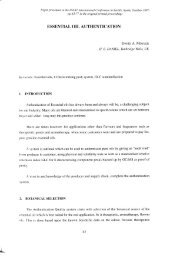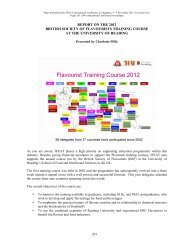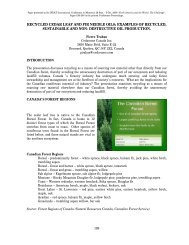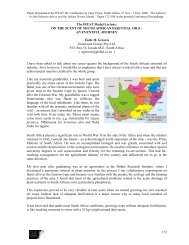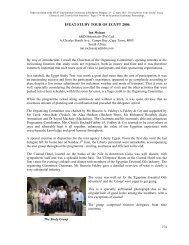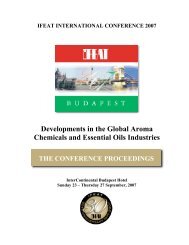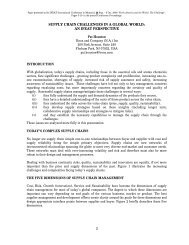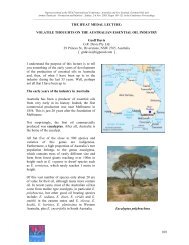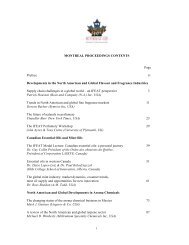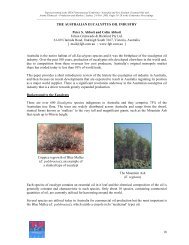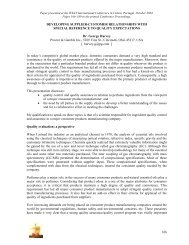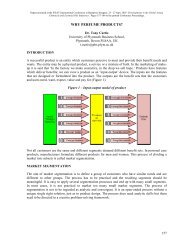EGYPT: THE ESSENTIAL OIL BREADBASKET OF THE ... - IFEAT
EGYPT: THE ESSENTIAL OIL BREADBASKET OF THE ... - IFEAT
EGYPT: THE ESSENTIAL OIL BREADBASKET OF THE ... - IFEAT
You also want an ePaper? Increase the reach of your titles
YUMPU automatically turns print PDFs into web optimized ePapers that Google loves.
Paper presented at the <strong>IFEAT</strong> International Conference in Lisbon, Portugal, October 2004.Pages 36–42 in the printed Conference Proceedings.<strong>EGYPT</strong>:<strong>THE</strong> <strong>ESSENTIAL</strong> <strong>OIL</strong> <strong>BREADBASKET</strong> <strong>OF</strong> <strong>THE</strong> MEDITERRANEANHussein A. FakhryA. Fakhry & Co.,1081 Corniche El Nil, Cairo 11451, Egypt[ a-fakhry@starnet.com.eg ]Egypt has a long historical association with aromatic plants and has been a major supplier of a rangeof essential oils and aroma extracts to the international market since the 1930s. In the past threedecades, challenges have been encountered on the market by the emergence of competition from newsuppliers, for example with geranium and jasmine. However, Egypt remains a very significant supplierand deserves the title of ‘the essential oil breadbasket of the Mediterranean’.Indicative recent annual scale of the main Egyptian products [2003 figures](tonnes)Herbaceous oils Allium oils ConcretesGeranium 80.0 Garlic 4.5 Geranium 0.4Basil linalool type 2.5 Leek 0.08 Basil Linalool type 0.5methyl chavicol 1.0 Onion 0.75 methyl chavicol 0.2Basil –l Seed / spice oils Carnation 0.25Chamomile, blue 1.2 Cumin seed 6.0 Cassie 0.4Celery leaf 0.5 Dill seed 0.8 Jasmin 2.7Coriander leaf 1.0 Fennel seed 0.8 Oranger 0.2Marjoram 4.0 Citrus oils Violet leaf 0.7Parsley leaf 1.0 Petitgrain mandarin 5.0Tagete 0.45 Petitgrain bigarade 1.0This presentation aims to provide an overview of the Egyptian industry today.Country backgroundEgypt is located in the northeast of Africa and hasa foot in Asia Minor (the Sinai peninsular). Itsnorthern border is the Mediterranean Sea, Libyalies to the west, Sudan to the south and Israelshares the northeast border in Sinai.The Tropic of Cancer passes through the AswanHigh Dam in the southern region and the broadclimate category is sub-tropical. The northernfringe of the country possesses a Mediterraneanclimate of hot dry summers and cool, wet wintersHowever, the dominant influence on thecountry’s climate arises from the fact that Egyptlies on the eastern edge of the Sahara Desert. Thishas governed the society and the economy fromthe dawn of civilization.36
Egypt’s land surface area is 1 million square kilometres but of this total only 5% is inhabited - in theNile Valley and Delta, an area equivalent in size to Switzerland. The transition from the narrow,highly fertile zone on the borders of the Nile to the desert is a rapid and dramatic experience for firsttime foreign visitors to, for example, the great pyramids at Giza on the outskirts of Cairo.A land of striking contrasts:Egypt’s population today is 76 million, predominantly confined within the narrow Nile valley, and thepopulation growth rate is currently 1 million / year. Each year around 0.7 million new workers enterthe marketplace and the unemployment rate is 15-17%.The major cities are:• The capital, Cairo (17-20 million people)• Alexandria, on the Mediterranean (5 million)• Ismailia and Tanta (each 0.8 million)• Port Said and Minya (each 0.7 million)The GNP figures for 2003 were: US$100 billion in total; growth of 5%; and US$1,315 / person.While a modern industrial capacity isdeveloping, for example in petrochemicalsand metallurgy, agriculture and the agrofoodindustry remain a significant source ofemployment and contribute 20% of GNP.Today, agriculture ranges from the intensivehigh technology farming through to thetraditional smallholder type.The essential oil industry earns US$15-17million annually through exports.37
The Essential Oils IndustryOriginsEgypt has had a close association with aromatic plants for over 5,000 years. From the ancientPharaohs, via the Persian, Greek, Arab, Ottoman, French and British presences, the country has gainedan extremely diversified legacy in terms of its endemic and introduced species. Some of the milestonesare:• The earliest recorded uses of aromatic plants in Egypt dates back to 3,100 BC at the timeof the first Pharoh, Narmer I.• Two thousand year later, during the reign of Queen Hatsheput (1480-1460 BC),commercial expeditions were sent to Somalia to collect and introduce myrrh and balsamtrees.• The first records of essential oil distillation in Egypt were made during the conquest ofAlexander the Great (332 BC).• Improvements and large-scale development of distillation methods arose after the Arabconquest of Egypt in 640 AD, together with the introduction of orange, jasmine and rose.The modern industry: 1960s/1980sIn 1912, the Frenchman Charles Garnier re-introduced jasmine near Cairo, specifically for extractionpurposes. This marked the early stage of the general move for relocation of the essential oil industryfrom southern Europe to lower production cost areas in North Africa. During the 1930s, Garnier alsoestablished the first geranium plantations in Egypt.The 1960s saw the large-scale development of Egypt’s modern industry, which led to its dominancefor a decade as the major world origin for jasmine concrete and geranium oil, supplanting the formerpositions of Grasse and Reunion respectively with these two products. In the peak years, theproduction of jasmine was 10-12 tonnes and well over 100 tonnes for geranium oil.The industry structure that emerged by the early/mid-1970s was as follows:• The geranium sector waspredominately a peasantfarmer cultivation activityaround Beni Suif andFayoum, 150 and 80 kmto the south of Cairorespectively, where therewere up to 80 distilleriesemploying Egyptianmanufactured equipment.Most of these distilleriesVillage geranium stillswere owned by the richer farmers, who grew geranium, supplemented their feedstockrequirement by buying in from neighbours and also carried out toll processing for other38
growers. This area also grew and distilled some other oils, including garlic and chamomile.The oils produced were sold to local agents of the Cairo-based exporters.• Production of most other oils, concretes and absolutes was undertaken by medium- tolarge sized companies in the Cairo, Barrage and Delta areas, which owned plantations andpossessed modern, European manufactured equipment. Three or four large companies,one of which was state owned, dominated this end of the industry.By the mid-1980s, some major products had become a victim of the economic drivers that had led tothe original establishment of the industry in Egypt: the emergence of competition from new, lowerproduction cost suppliers. Jasmin concrete production had been developed in India and China (YunnanProvince) had captured a large share of the geranium oil market through aggressive price competition.Egyptian geranium growers also were suffering from reduced productivity and profitability as theresult of plant disease, while improvements in road infrastructure opened up the alternative of moreprofitably supplying the vegetable market in Cairo. Jasmine concrete production fell at around 5tonnes and geranium to 45 tonnes annually around 1984.At the end of the 1980s, the Egyptian geranium oil industry also suffered the full effects of theeconomic collapse of the USSR, previously a major importer under barter trade arrangements.Additionally, the early 1990s saw a period of geranium oil oversupply to the international market byChina in the first phase of introduction of economic liberalisation policies.The Egyptian industry todayIn the more recent period, the Egyptian industry has undergone some restructuring in response tomarket and economic forces and has also undertaken product diversification.Geranium production remains dominated by peasant farmers.Egypt is a significant producer and exporter of culinary herbs and spice seeds and this sector isperhaps three-fold greater in value than the essential oils industry. The production surplus from thissector furnishes the raw material for distillation herb and spice seed oils, such as marjoram, cumin andchamomile. Consequently, the price of these oils fluctuates annually depending upon the local marketprice for the raw material.Some 10 large companies are involved today in cultivation / distillation of essential oil crops. For thebiggest companies, however, cultivation has become less important than their trading activities(including buying oil from farmers). Less than 10 very big companies account for 80% of the turnoverfor essential oils.There is no foreign investment today in the production of essential oils and aroma materials in Egypt.Those few major international players who made investments in the past exited some years ago.The local branches of the major global F&F companies are involved only in compounding fragrancesand flavours for the local and Middle East markets.The main export destinations for Egypt’s essential oils, concrete’s, etc. are Europe and North America.39
U S A im p o rts o f E .O . fr o m E g yp tU S D M i o10.008.006.004.002.000.001999 2000 2001 2002 2003YearsE U im p o r ts o f E .O . fro m E g yp tE U R M i o10.008.006.004.002.000.001999 2000 2001 2002 2003YearsThe list of Egypt’s main products today, together with the indicative scale of annual production, hasbeen given in the table at the commencement of this paper. The following provides comments on afew of these products.Geranium oil EgyptSpecies grown: Pelagonium asperumOil signature: 10-γ epi-eudesmol (3-6%)Production seasons: Oct./Nov. and May/JuneAnnual production scale:60-130 tonnes (over 1999-2003)Recent production has been greater than inthe late 1980s and early 1990s. A particularlylarge output by Egypt has occurred followinga year of poor weather induced supplyshortfalls in China and an expected highmarket price.The EU remains the major market destinationfor Egypt’s geranium oil.Quantity (Tons)EU imports of Geranium from Egypt8060402001999€33/kg2000€51/kg2001€50/kgYears2002€55/kg2003€45/kg40
Jasmine EgyptSpecies grown: Jasminium grandiflorumAnnual production scale:2.2 – 3 tonnes (over 1999-2003)EU imports of Jasmine from EgyptQuantity (Tons)10864201999€697/kg2000€708/kg2001€280/kg2002€674/kg2003€614/kgYearsBitter orangeSpecies: Citrus aurantium var. amaraAnnual production:• Neroli oil, 110-130 kg• Neroli concrete, 150-200 kg• Petitgrain bigarde oil, 1,000 kg• Bitter orange oil, 750kgThe FutureEgypt may be confidently expected to continue as a major supplier of essential oils and aromamaterials to the world market.41
It is blessed with a number of unique characteristics:• a climate suitable for the cultivation of a wide range of crops;• no frosts (or hurricanes), no droughts, no floods;• diverse soils, plenty of sun and a permanent water supply;• only 4 hours (±) flight away from any European capital and direct, reliable sea and airconnections to destinations around the world.Also, labour is available at competitive costs.Hussein Fakhry is a second-generation member of A. Fakhry & Co. Thecompany was founded in 1955 and, today, it is the oldest, family-owned essentialoil processing company still in active in Egypt. After completing high school inFrance and Switzerland, Mr. Fakhry went on to study at Clark University in theUnited States and graduated in Cartography/Remote Sensing and MarineScience. He took over the management of A. Fakhry & Co. in 1997 and, togetherwith his wife Cherifa, has led the company to become one of Egypt’s leadingessential oil producers and exporters of a diversified range of conventional andorganic products.42



